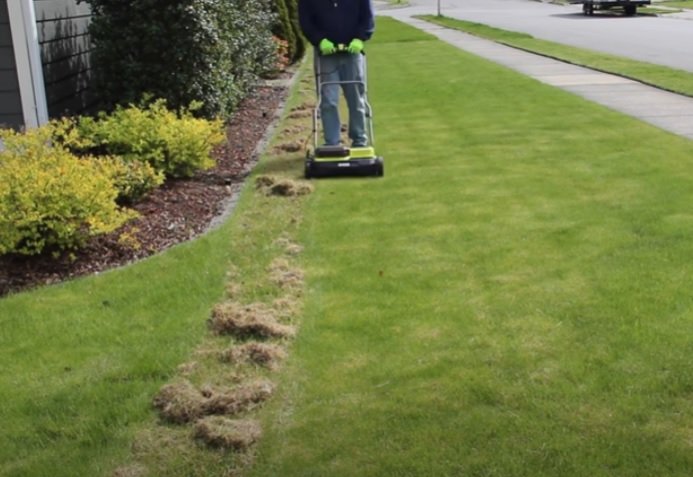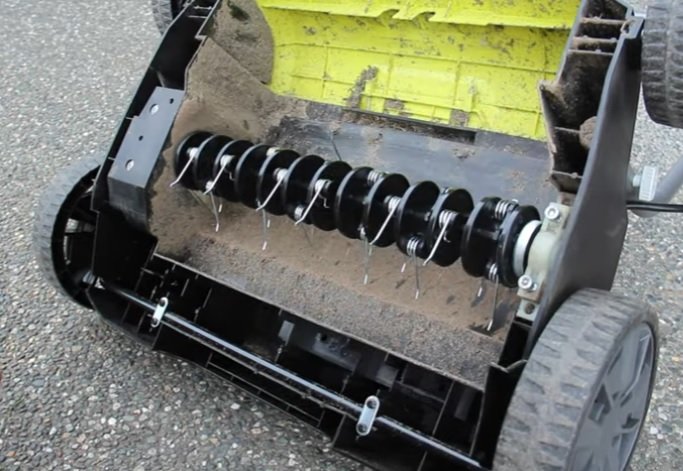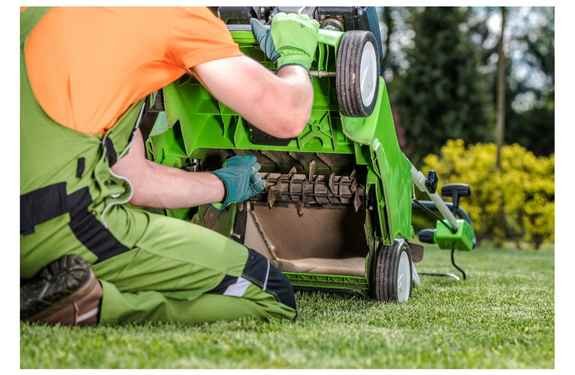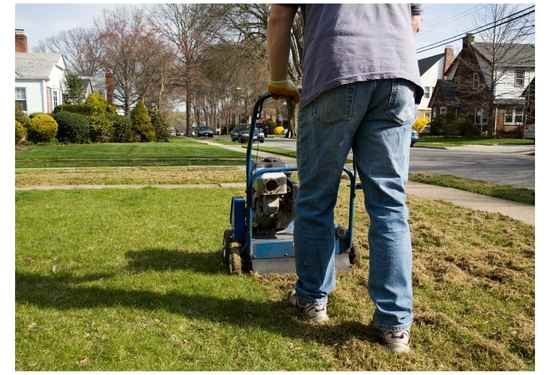We're an affiliate
We hope you love the products we recommend! Just so you know, we may collect a share of sales or other compensation from the links on this page. Thank you if you use our links, we really appreciate it!
Though the topic of power raking is one that can evoke strong opinions from those who love their lawns. The truth is that this landscaping tool has many benefits. Power raking is the process of using a special rake to remove thatch, debris, and dead grass from a lawn. It is an important part of lawn care because it helps to improve the health of the lawn, making it more resistant to pests and diseases.
What Is Power Raking?
Power raking is a lawn care technique that involves using a special machine to remove dead grass, leaves, and other debris from the surface of the lawn. Many people do this type of raking in the springtime to prepare the lawn for the growing season. Although you can do it in the fall as well.

This machine can also remove a thin layer of thatch. This is a layer of living and dead organic matter that can build up on the surface of the lawn. Thatch can prevent water, air, and nutrients from reaching the roots of the grass, so it’s important to remove it regularly.
If you have a deep layer of thatch, you will need a dethatching machine instead of a power rake.
What is the Difference Between a Power Rake and a Dethatcher?
Many people ask which is better power raking or dethatching?
Power raking for the lawn is the process of mechanically removing dead thatch from your lawn. A power rake is a machine that uses a drum with flexible tines that rotate under the deck. These rotating tines will break loose the dead grass and other debris, including thatch. The power rake only removes a thin layer of thatch.

It differs from dethatching, which uses a vertical mower with blades that slice into the ground, pulling up grass roots and thatch. Dethatching is a good idea for lawns with thick thatch. This machine gets deeper into the thatch and brings it to the surface.

While a small amount of thatch can actually be beneficial to your lawn, too much thatch can be problematic.
Too much thatch can prevent water, air, and nutrients from reaching the roots of your grass. This can lead to lawn diseases, insect infestations, and a general decline in the health of your lawn. Thatch also provides a perfect environment for rodents and other pests to hide and build nests.
Dethatching is removing the thatch from your turf. This can be done with a special dethatching rake or by hiring a professional lawn care company.
Dethatching and power raking are best done in the spring or fall when the grass is actively growing.
What Time Of Year Is Best To Power Rake?
The best time of year to power rake a lawn is in early fall. This allows you to remove all the dead grass and debris that has accumulated over the summer months, and making time for the lawn to recover with fresh, new growth.
How Often Should You Power Rake Your Lawn?
The answer to this question depends on a few factors. The first is the type of grass you have. If you have a very delicate grass, such as Bermuda, you will want to power rake less often than if you have a heartier grass.
The second factor is whether you bag your clippings. Power raking removes debris from the lawn. The clippings that don’t decompose will need to be removed.
Generally, most people should power rake their lawns once or twice a year. This will help to keep the thatch level down and allow your grass to grow healthy and strong.
What Are The Benefits Of Power Raking?
There are many benefits to power raking, including the removal of dead leaves and grass, aeration of the soil, and the stimulation of new growth. Power raking can also help to control weeds and thatch build-up.
One of the major benefits of power raking is that it removes dead leaves and grass from the lawn. This debris can block sunlight and air from reaching the grass, which can lead to a weak and unhealthy lawn. Power raking also helps to aerate the soil, which allows vital nutrients and water to reach the roots of the grass. In addition, power raking stimulates fresh growth by removing old growth that has died back.
Power raking can also help to control weeds by removing their seeds and root systems. Thatch build-up is another common issue that power raking can help with. Thatch is a layer of dead organic matter that accumulates on top of the soil. This layer can prevent water and nutrients from reaching the roots of the grass, leading to a weaker lawn.
Power Rake Before Seeding and Feeding
It’s no secret that a healthy lawn requires some effort to maintain. But what about when your lawn needs a little extra help? If you’re looking to improve the health of your lawn, power raking is a good start.
By removing all the debris from the lawn, you give the new grass seed a chance to reach the soil. Your lawn fertilizer will also be more effective.
How To Power Rake Your Lawn Correctly.
To begin, mow your lawn pretty short. Most people set the mower height to 2 inches. When you mow, bag the clippings so the power rake doesn’t have to work extra hard to do its job.
Once you’ve mowed the lawn, start power raking in back-and-forth passes from front to back. You should loosen up quite a lot of debris.
When that task is complete, pick up the debris using a mower, leaf blower or rake and remove it from the lawn.
Now, power rake the yard again, only this time you will go from side to side. This allows you to lift more debris from the yard. Remove the debris and check your results.
You should be able to see dirt beneath the grass. If so, you are probably in good shape. If not, you can go over the lawn again and this time follow a diagonal pass pattern.
When power raking, be sure to go over the entire lawn evenly. You don’t want to miss any spots or you’ll end up with patchy areas.
And finally, once you’re done power raking, you are ready to seed and feed your lawn. This will help ensure a lush, green lawn all season long!
Conclusion
Is power raking good for the lawn? The answer is yes. While some may disagree, the fact is removing debris with a power rake can only be good. It will prepare your lawn for seeding in the fall or the spring. I, for one, prefer power raking in the early fall, followed by overseeding and fertilizing. Let me know your thoughts.


2 thoughts on “Is power raking good for the lawn?”